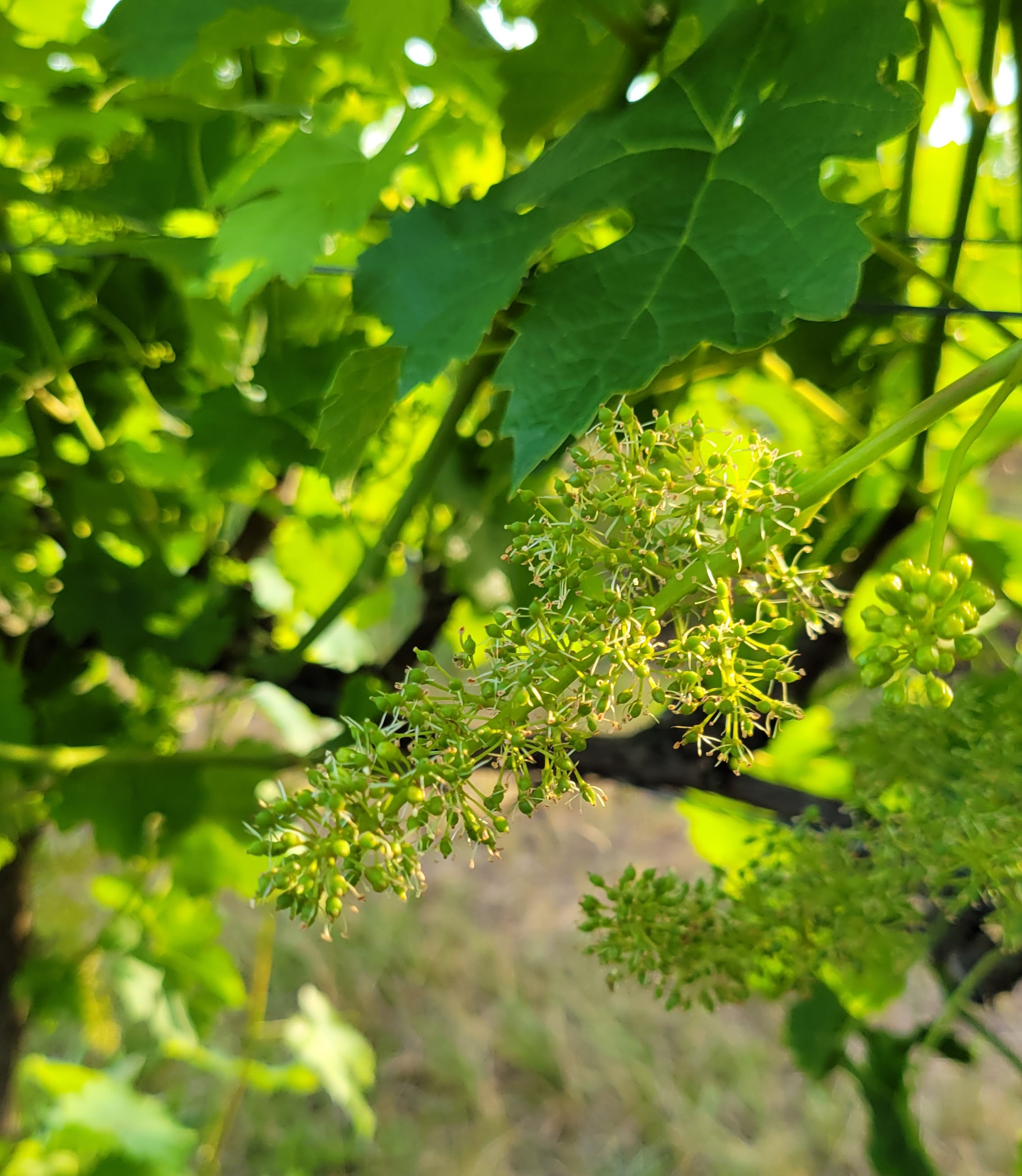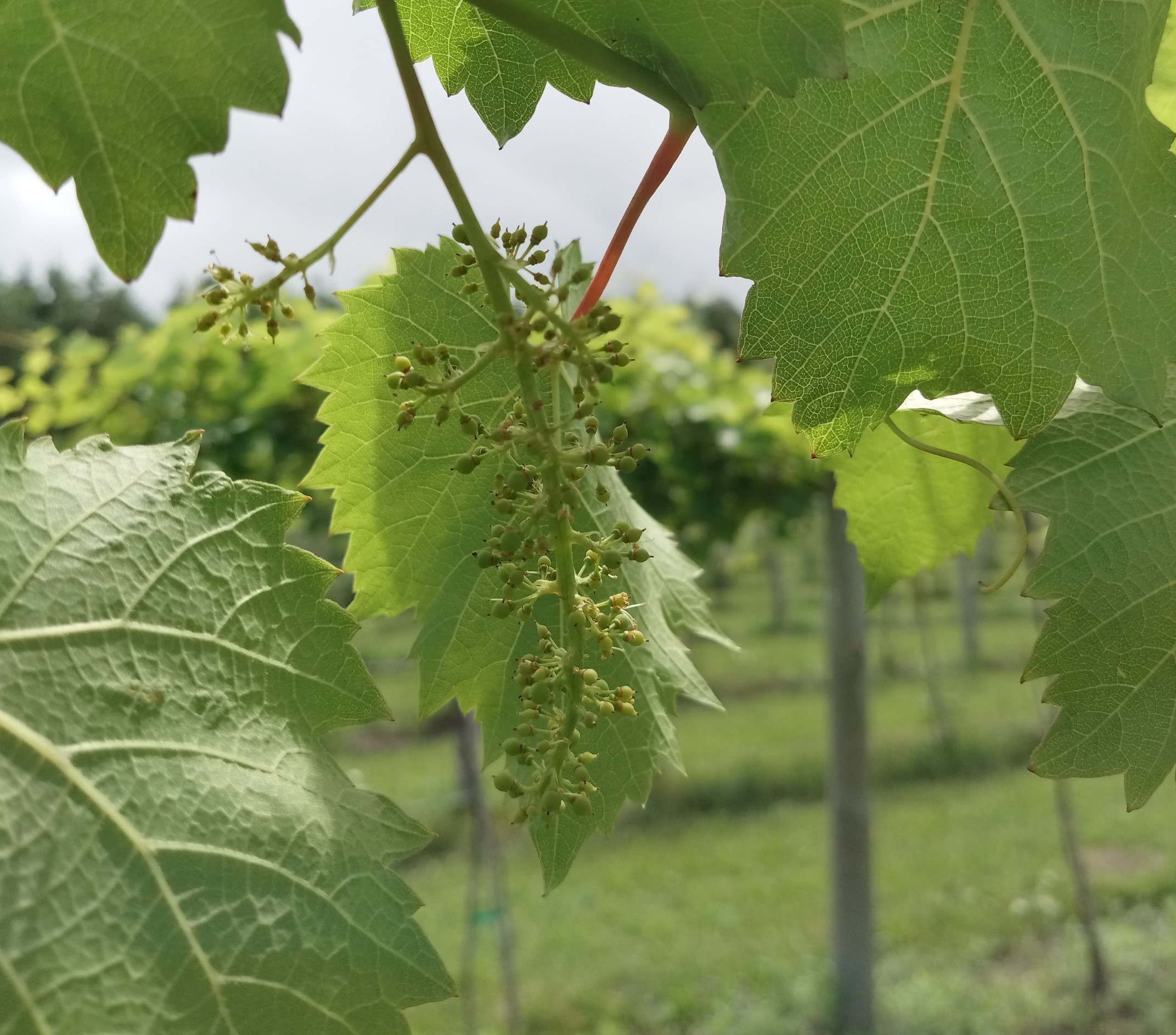Michigan grape scouting report – June 26, 2024
Spotted lanternfly was identified in a new site in southern Monroe County outside fruit-growing areas. MSU and agencies monitor statewide, including vineyards. Report sightings to DNR's Eyes In The Field.

Weather
Click the following links for detailed seven-day forecasts for various grape production regions.
Southwest
Southeast
Northwest
See the latest agricultural weather outlook from Jeff Andresen, Michigan State University state climatologist.
Report on growing degree days (GDD)
- Southwest Michigan GDD summary from March 1 through June 25, 2024
- Southeast Michigan GDD summary from March 1 through June 25, 2024
- Northwest Michigan GDD summary from March 1 through June 25, 2024
The following table summarizes the GDD base 50 degrees Fahrenheit for the current week and the previous week, as well as the accumulated GDD for each location.
|
Michigan grape growing region |
Current GDD 50 F |
GDD 50 F last week |
Collected the past week |
|---|---|---|---|
|
Benton Harbor (SWMREC) |
1,176 |
989 |
187 |
|
Fennville |
1,027 |
863 |
164 |
|
Lawton |
1,173 |
987 |
186 |
|
Average for southwest Michigan |
1,138.9 |
956 |
182.9 |
|
Romeo |
1,020 |
859 |
161 |
|
Average for southeast Michigan |
1,090 |
919 |
171 |
|
Old Mission |
703 |
597 |
106 |
|
Petoskey |
673 |
575 |
98 |
|
Traverse City (NWMHRS) |
746 |
636 |
110 |
|
Average for northwest Michigan |
707.6 |
603 |
104.6 |
Vine growth
Bloom is completed in juice grape and hybrid cultivars in southwest Michigan. Some early hybrids like Marquette and Brianna are at buckshot berry. Vinifera bloom on primary shoots is almost finished and the fruit set is looking good. Vinifera varieties with secondary shoots are blooming now.
With bloom complete in juice grapes, growers are performing crop estimations. The spring freeze has caused more damage than earlier expectations. The current estimate is for harvest volumes of Michigan juice grapes to be approximately 10-20% of the average.
Growers are managing for powdery mildew protection, though spray schedules have been difficult with the high temperatures and recent winds and rain.
Shoot positioning in wine grapes continues. Combing has begun for juice grapes.
In northern Michigan, all the vinifera wine grapes are in full bloom or close to finishing. Clusters are still expanding, initial berries are distinguishable, and fruit set in early varieties such as Chardonnay, Cabernet Franc and Pinot noir is very close.

In the Tip of the Mitt region, hybrid cultivars are 90% completed with bloom. Vinifera varieties have begun to bloom. Heat, humidity and intense rainfall over the past week has continued to increase disease pressure. Black rot and phomopsis are being observed in both hybrid and vinifera cultivars. Rose chafer observations continue. Populations of these beetles have increased in some locations to the point where management has been warranted. Shoot positioning continues.

See this chart for grape growth stages.
Horticulture
In vineyards of southern Michigan, many growers are training new shoots from the base of the vines to replace older or damaged trunks and cordons as a result of the past winter damage. In these cases, very little trunk cleaning or shoot thinning is currently being done. In some cases, new canes that were laid down during last winter have been brought up for new trunks and cordons. In these vineyards, some shoot thinning and trunk cleaning has been completed. Shoot thinning and trunk cleaning should be underway in many varieties in the northern vineyards.
Shoot thinning plays a crucial role in canopy management, offering multiple benefits such as enhanced air circulation, reduced disease susceptibility, minimized shading, improved spray penetration, reducing over-cropping and ultimately elevating fruit quality during the harvest period. It is advisable to perform shoot thinning when the shoots reach a length of 5-12 inches, ensuring they are still easily breakable from the woody tissues.
For more comprehensive information on shoot thinning and other early season vineyard management practices, please refer to the Michigan State University Extension article, "Early season vineyard management."
Diseases
During this time of year, the primary diseases of concern for grape growers are phomopsis, black rot, anthracnose and powdery mildew. If you're seeking detailed insights into pre-bloom fungicide options and the effects of rain on disease spread, I recommend referring to a grape scouting report from earlier or exploring an article on early-season disease management. It's worth noting that some growers have recently observed isolated cases of downy mildew infections in northern vineyards. Southern vineyards have been seeing early infections of Phomopsis and are beginning to see black rot lesions.
As bloom continues in southwest Michigan, start choosing fungicides that control all the fruit diseases. For example, with downy mildew we are most concerned with fruit infection at this time and sprays should be timed prior to bloom and at bloom for optimal control. Downy mildew is caused by a fungal-like organism, so many site-specific systemic fungicides that target other spring diseases do not work on downy mildew. Effective fungicides for downy mildew include products in FRAC codes 4, 11, 21, 40 and 45 as well as phosphorus acid salts and some biologically based products.
With the exception of powdery mildew, these spring disease infections typically require rain events. It only takes 0.1 inches of rain above 50 degrees Fahrenheit to trigger a possible infection. Viticultural practices that reduce canopy wetness such as good irrigation timing, leaf removal and good weed management can reduce many of these diseases in a vineyard. Typically, DMIs (FRAC 3), captan and EBDCs (FRAC M3) are effective for Phomopsis, black rot and anthracnose.
Insects
A second site in Michigan has been found with live spotted lanternfly, as announced by the Michigan Department of Agriculture and Rural Development this week. The site is in southern Monroe County just north of Toledo, Ohio, and is not near fruit agriculture. Michigan State University is working with a network of agencies monitoring sites across the state, and these include multiple vineyard locations. Growers can help out by staying vigilant for these invasive insects and reporting any suspect detections to the Department of Natural Resource’s Eyes In The Field.
Grape berry moth larvae can be found in grape clusters in southwest Michigan vineyards, especially those with low crop load that have not been treated with insecticide yet. Scouting vineyards along the edges and into blocks can quickly show whether your locations also have activity of grape berry moth larvae currently, and what stage of development they are at. Some insects develop more slowly when it is extremely hot, but we don’t yet know how to adapt the grape berry moth model for extreme heat days, so it has been accumulating heat units quickly during this warm spring.
Based on the degree-day model calculations for grape berry moth and using wild grape bloom observations from this spring in southwest Michigan to set the starting point for adding degree-days, the start of second generation egglaying has come early. The model is predicting the start of second generation egglaying in southern Berrien County this week and proceeding into early July at further north locations. It is important to realize that this model predicts the start, but there will be an extended period of egglaying and larvae developing into July.
Based on the conditions in your region and the vineyard crop load, consider the need for repeat applications during this period to protect clusters from grape berry moth. Products with extended activity and those with performance under high heat and sunlight conditions should be considered given this year’s weather and the extended egglaying from berry moth during the summer.
Even if a vineyard isn’t being harvested, we recommend continued scouting for leafhoppers, beetles, etc. Neonicotinoid insecticides such as Assail and Admire Pro can provide protection against leafhoppers, rose chafer and tumid gallmaker if present in the same vineyard site.
SAM Tool for vineyard management
The Sustainable Agricultural Management (SAM) Tool is a comprehensive software application designed to assist grape growers in managing vineyards more effectively. Please sign up to access the SAM Tool. The application is developed by Karen Chou of Michigan State University (MSU) Extension in collaboration with MSU’s Department of Computer Science and Engineering. Dennis Phillips is the lead software developer.
The application offers a range of features designed to save time and enhance vineyard management efforts. It employs robust data security and accuracy measures and can be used for mapping sub-fields, generating auto-populated spray records, and issuing warnings about the consecutive use of the same pesticides to minimize the development of pesticide-resistant pests.
Additionally, the app displays your spray tasks on a calendar and helps to identify restricted entry fields and manage preharvest sprays using the restricted-entry interval and preharvest interval databases. It also facilitates task assignments, sends task reminders for managers and workers, and allows the upload of photos and scouting notes directly from the field, which can be viewed later within the application.
You can also help the Michigan Wine Collaborative pilot the Michigan Vine Balance Workbook, a sustainability certification program, through the website. Please fill out this brief survey to answer one question and enter your contact information for Chou to offer you personalized guidance on beginning to use this application.
Upcoming events
Parallel 45 Vines & Wines Pre-Veraison Meeting: Boost Grapevine Productivity. Gain valuable insights from industry experts at our upcoming hybrid meeting on July 12. We'll focus on presentations about compost tea, biochar and organic compost from Krull's. Don't miss out – pre-registration is required!
The 35th annual Michigan Viticulture Field Day and inaugural Michigan Enology Experience are approaching. MSU’s famous field day and steak dinner is back on July 31. We are now adding a second day just for the winemakers.
Dirt to Glass™ 2024: Elevating Michigan Wine from the Ground Up, Aug. 22-23. Dirt to Glass aims to connect growers and producers each year and provides information to support the Michigan grape and wine industry in understanding the critical relationship between better farming and world class wine.
As a collaboration between Michigan State University, Michigan State University Extension and industry innovators and educators, this groundbreaking event disseminates the most current research and cutting-edge practical information to elevate the grape and wine industry.
This year's conference will continue the journey started in 2022, aiming to elevate the Michigan grape and wine industry through a deeper understanding of soil health and fertility, carbon cycle and sequestration, and soil-vine interaction, all crucial sustainability elements in producing high-quality grapes and wines from vineyard to economic sustainability. Each technical session will be complemented by wine educational sessions.
Related articles
- Early season vineyard management
- Early season control of grape berry moth in Michigan vineyards for 2022
- Rose chafer management for northwest vineyards
- Fruit insecticide registration update for 2023
- Southwest Michigan fruit update – June 4, 2024
- Michigan grape scouting report - June 8, 2022
- 2022 MSU Fruit Pest Management Guide (E-154)
- Grape growth stages
- Early season vineyard disease management
- A Mobile Guide for Grape IPM Scouting in North Central and Eastern U.S.
- Using the MSU Enviroweather grape berry moth model in 2018



 Print
Print Email
Email
